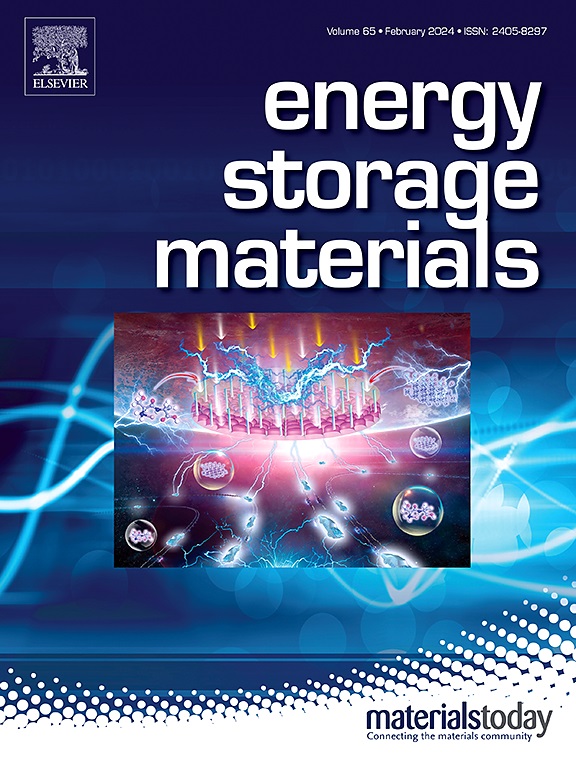Phenazine-based cathodes enabled by reducing LUMO energy level for high mass loading and low temperature zinc-organic batteries
IF 18.9
1区 材料科学
Q1 CHEMISTRY, PHYSICAL
引用次数: 0
Abstract
Organic small molecule electrode materials are regarded as highly promising cathode materials for aqueous zinc ion batteries (AZIBs) due to their tunable structure, environmental friendliness, and sustainable generation. However, rapid capacity degradation and sluggish kinetics hinder their practical application, particularly at high mass loadings and low temperatures. Here, we design and synthesize two conjugated small molecules with different numbers of carbonyl groups (namely nitrogen heterocyclic dione (PZPQ), nitrogen heterocyclic tetraketone (PZDPQ). In addition, the introduction of electron-withdrawing carbonyl groups lowers the energy level of the lowest unoccupied molecular orbital (LUMO) of phenazine and extends the π-conjugated system, which enhances the voltage, capacity and redox kinetic of PZDPQ. Thus, the PZDPQ cathodes for AZIBs exhibit high capacity of 340 mAh g−1 at 0.2 A g−1, a high capacity retention of 97.8% after 8000 cycles, and outstanding rate performance (200 mAh g−1 at 10 A g−1), even function efficiently at high mass loading of 49 mg cm−2 and low temperature at -40 °C. Further mechanistic researches by in-situ quartz crystal microbalance demonstrate that the fully conjugated molecular configuration enables reversible Zn2+/H3O+ synergistic storage.

基于非那嗪的阴极通过降低LUMO能量水平来实现高质量负载和低温锌有机电池
有机小分子电极材料具有结构可调、环境友好、可持续性等优点,被认为是极具发展前景的水锌离子电池正极材料。然而,快速的容量退化和缓慢的动力学阻碍了它们的实际应用,特别是在高质量负载和低温下。本文设计并合成了两个羰基数目不同的共轭小分子,即氮杂环二酮(PZPQ)和氮杂环四酮(PZDPQ)。此外,吸电子羰基的引入降低了非那嗪的最低未占据分子轨道(LUMO)的能级,扩展了π共轭体系,提高了PZDPQ的电压、容量和氧化还原动力学。因此,用于azib的PZDPQ阴极在0.2 A g−1时具有340 mAh g−1的高容量,在8000次循环后具有97.8%的高容量保持率,以及出色的倍率性能(10 A g−1时200 mAh g−1),即使在49 mg cm−2的高质量负载和-40°C的低温下也能有效地工作。通过原位石英晶体微天平进一步的机理研究表明,完全共轭的分子构型能够实现Zn2+/ h30 +的可逆协同存储。
本文章由计算机程序翻译,如有差异,请以英文原文为准。
求助全文
约1分钟内获得全文
求助全文
来源期刊

Energy Storage Materials
Materials Science-General Materials Science
CiteScore
33.00
自引率
5.90%
发文量
652
审稿时长
27 days
期刊介绍:
Energy Storage Materials is a global interdisciplinary journal dedicated to sharing scientific and technological advancements in materials and devices for advanced energy storage and related energy conversion, such as in metal-O2 batteries. The journal features comprehensive research articles, including full papers and short communications, as well as authoritative feature articles and reviews by leading experts in the field.
Energy Storage Materials covers a wide range of topics, including the synthesis, fabrication, structure, properties, performance, and technological applications of energy storage materials. Additionally, the journal explores strategies, policies, and developments in the field of energy storage materials and devices for sustainable energy.
Published papers are selected based on their scientific and technological significance, their ability to provide valuable new knowledge, and their relevance to the international research community.
 求助内容:
求助内容: 应助结果提醒方式:
应助结果提醒方式:


